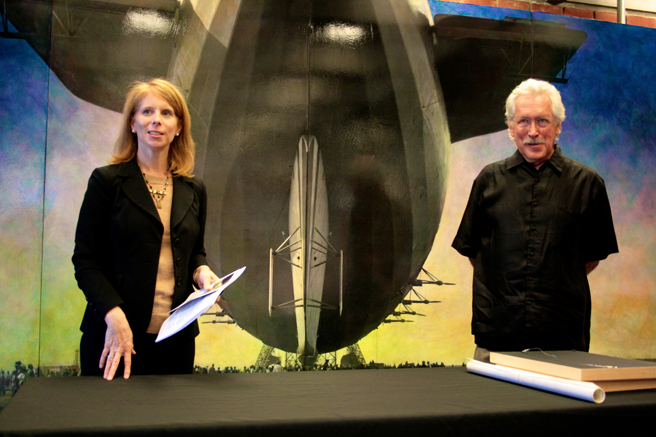Thursday evening was a stellar night at NUMU with Los Gatos artist Rick Guidice, The NASA Paintings and a fabulous NASA Ames Research Center panel discussion, Our Place in Space: A Panel Discussion About the Future of Space Settlements! This dynamic exhibition of visionary space settlements Guidice developed for NASA in the 70’s helped to shape how we could see our future in space and has informed much later work on the subject. It runs from September 17, 2015 though to February 14, 2016.
NUMU’s Curator of Art, Marianne McGrath introducing Rick Guidice for a informal talk about this series and his experience working with NASA.
Rick Guidice unscrolling one of his early drawings of Mars space suits that had been modeled for him at NASA Ames Research Center.
Such an enthusiastic and knowledgable turnout for Rick Guidice’s talk, the room was filled with scientists, engineers and artists!
Rick Guidice explained how he used dramatic changes in scale of the astronauts to indicate how incredible large these space settlements were.
Astronauts tethered to an early space shuttle in a detail from a Guidice painting.
Spellbound.
In Mass Driver with Solar Power Station, an acrylic painting from 1977, Guidice explained how he chose to paint it from an unusual perspective – one where the earth was floating above instead of under our feet. He even signed it to make sure the orientation was maintained in future publications but to no avail, we earthlings are so fixed in our imagination, it was often printed upside-down.
Guidice’s initial idea was to develop practical, dense housing for these space settlements but NASA had something more reminiscent of the pastoral French countryside in mind.
Here’s a detail of agriculture in space, from a Rick Guidice painting. Maybe this is where The Muppets “Pigs in Space” concept came from?
Full room for an engaging storyteller!
The forced perspective, raking angles, high contrast, bold colors and texture seen in this detail from an asteroid mining device illustration, are just some of the artistic devices that make Guidice’s work so exciting.
NUMU Executive Director, Lisa Coscino welcoming the NASA Ames Research Center panelists speaking on Our Place in Space: A Panel Discussion About the Future of Space Settlements.
Panel Moderator, Alexandra Hall (Principal, Sodor Space Agency LLC) leading an engaging panel discussion on the future of space settlement with guest scientists.
Dr. Ann-Sofie Schreurs ( NASA Postdoctoral Program Fellow)
Sidney Sun (Chief of Space Biosciences Division at Nasa Ames Research Center)
Lynn D. Harper (Lead of Integrative Studies for both the Emerging Commercial Space Office, reporting to the Office of the Chief Technologist at NASA Headquarters & the NASA Ames Research Center Space Portal.
Yes, it was that kind of amazing night! So many great minds sharing interesting research and posing engaging questions.
The panel spoke on falling in love with space, their individual areas of study, the importance of human psychology in space, of the impact on the human body and how we may be bio engineered or evolve to better cope with issues like bone density loss and muscle atrophy. There were questions too of how our own colonies of bacteria might be kept in check as they seem to become more virulent in space. How space junk was an issue and recycling is critical. For example, even clothes can not be washed in space and must be trashed in a week – could they be recycled or maybe self cleaning clothing can be bio-engineered? Bio organisms will prove to be an important component in creating organic systems to recycle water and waste in general.
There was talk of how it will be necessary to develop outer orbit mining and manufacturing and recycling of the the highly processed space debris that is already in orbit (some 12 million tons) There was talk of the excess carrying capacity of current space launches and how material for the creation of these settlements could be sent, taking advantage of the extra room and be stored in zero gravity.
When I asked a question about who owns space (now that there are so many commercial entities vying for a piece of the cosmic pie) I got an unexpected answer from a member of the audience, Daniel Faber, CEO of Deep Space Industries – (asteroid mining anyone?) Apparently The Outer Space Treaty is the only thing currently in pace and while it regulates some things (no nukes on the moon) it has a non-interference policy when it comes to mining – Faber feels taxes will be collected by the countries from which the mining companies are based.
Harper felt that the World Bank could also act to collect a percentage of profits that might be reinvested in global space mining/ manufacture.
It’s all a ways out yet, but maybe not as far as we think – fascinating!














